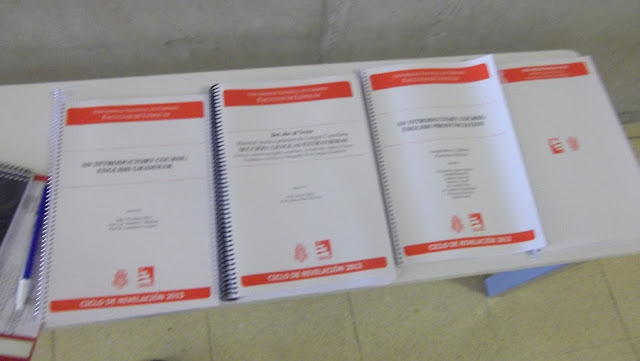After my negative experience at the anthropology building, I decided to go as an observer to the language school at the Universidad Nacional De Cordoba (UNC). The administrator at the front desk was as blunt as a board when she told me that I could enroll as a conditional student, but I needed to have my diploma and transcripts from the States validated by June or I’d get dropped from the career program.
I wasn’t sure if I’d get all the paperwork done in time, but I knew it wouldn’t hurt to go in as an observer and check out the course curriculum. If anything, 2013 would be like a trial run. Whatever bumps and bruises I experience this year, I'll get a second chance to do it again the following year.
I was pleasantly surprised to find that the language school building was much cleaner than the anthropology building I’d visited a few days earlier.
I had to buy four books for the cursillo, which is a 6-week term that determines if the students are eligible for the career program. Once students pass the cursillo, they can begin the first-year career term. If they fail, they essentially wash out and have two options. One is to either reapply next year, or they can try again as an independent student. The total cost of the books was 125 pesos, which is about 25 U.S. dollars.
I was excited and nervous about taking my first steps toward a degree at the university, but the excitement quickly turned into disappointment and frustration.
I had two professors, neither of which had ever traveled to an English-speaking country in their lives. I'm not making this up. They admitted it to me. They had thick accents and an average knowledge of the English language.
The first professor didn’t have a clue what a double chin was. She told the class that a double chin was someone who has a split or a gash that gives off the appearance of two chins. Then she went on to explain that people in the U.S. and in the U.K. don’t ever use the term “puffy eyes”. I’ve seen enough Visine commercials, which reference the term “puffy eyes” to know the term is used.
Then she corrected a student who stated that the word “seaside” was never used in the English language and that the correct term is beachside. Now, I lived most of my childhood in South Florida. Believe me, seaside is as much a term as beachside. Then the professor claimed that the term skinny was considered a taboo because it’s a slang term and that the correct word was slender. She couldn’t pronounce the word iron correctly. She kept saying I-RON and that’s not the way the word is pronounced.
The second professor taught phonetics. He was more knowledgeable, but his accent was strong. He stressed that at the language school, British English is the preferred style of teaching over American English. I felt a bit offended by the fact that kept stating that American English was imperfect. Is it different from British English? Yes, but I don’t consider it imperfect any more than I can consider Argentine Castilian an imperfect version of the language spoken in Spain or other Latin American countries. Oddly enough, he didn't mention how imperfect American English was until after the break. During the break, I spoke with him and told him I came from the States. Maybe it's a coincidence, but still... in my opinion, he was rude!
If this is how the rest of the course is going to go, I’m in for a rough time. I hate correcting professors, especially those that don’t like being corrected, but I can’t just sit there and pretend like they’re teaching the lessons correctly when they’re not. The students seem far more knowledgeable than the professors. It’s only my first day and I’m having some serious doubts about whether this was the right career choice for me.





















